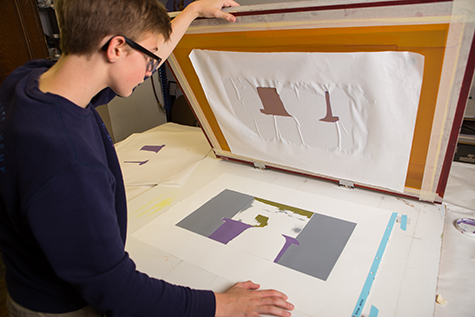The Vital Guide to Comprehending Screen Printing and Its Versatile Uses
Screen printing has an abundant history that goes back to ancient times, advancing right into an innovative strategy utilized throughout different markets today. This guide checks out the complexities of the screen printing process, detailing its applications in advertising and marketing, home, and style décor - 10:9 Design Embroidery. Recognizing these basics can open up imaginative capacity for both creative and industrial jobs. The complying with sections will reveal crucial ideas and techniques to boost one's screen printing ventures
The Background of Screen Printing
Although screen printing has origins that map back centuries, its evolution reflects the artistic and technical advancements of various cultures. Coming from in ancient China, the technique was at first utilized for embellishing textiles and later infect Japan, where it came to be indispensable to Ukiyo-e woodblock printing. The approach moved to Europe in the 18th century, where it gained popularity amongst artisans and industrial printers. The invention of picture solution in the 20th century revolutionized screen printing, enabling more detailed styles and higher effectiveness. Artists like Andy Warhol better pushed its appeal, making use of the medium to create renowned jobs that blended commercialism and fine art. By the late 20th century, screen printing had developed itself as a functional strategy, employed in style, advertising and marketing, and fine art. Today, it continues to develop, integrating digital innovation and expanding its applications across various markets.
The Screen Printing Process Explained
Screen printing transforms creative visions into concrete designs through a series of accurate steps. At first, a picture is developed and after that transferred onto a screen, normally constructed from great mesh textile extended over a structure. A light-sensitive emulsion is used to the screen, which is subjected to light, hardening in locations not covered by the photo. After rinsing the unhardened solution, a stencil is formed.
Next off, the screen is put over the substratum, whether it be fabric, paper, or an additional product. Ink is then pushed via the open locations of the pattern utilizing a squeegee, depositing the layout onto the substrate listed below. This procedure can be repeated for multiple shades, requiring separate displays for every shade. Finally, the published product is cured utilizing heat to guarantee the ink adheres properly, causing a sturdy, dynamic style ready for usage.
Types of Screen Printing Techniques

In addition, specialty strategies, such as discharge screen printing, eliminate color from the textile to create softer prints, while aluminum foil screen printing applies metallic aluminum foil to accomplish a shiny finish (10:9 Design contact). Each technique supplies distinct attributes, providing to numerous innovative needs and manufacturing scales, inevitably expanding the opportunities within the screen printing domain name
Applications of Screen Printing in Numerous Industries

Additionally, the signs and marketing sectors make use of screen printing for creating attractive display screens and banners. read this article This method permits for bold colors and complex layouts that capture interest. In electronics, screen printing is utilized for using conductive inks to circuit boards, vital for element connections. Additionally, the home decoration sector embraces screen printing to produce distinct styles on fabrics and wall surface art. On the whole, screen printing serves as an essential tool across varied areas, boosting products with customized and aesthetically enticing graphics.
Tips for Effective Screen Printing Projects
While undertaking a screen printing task, cautious focus to information can considerably enhance the final result. First, choosing high-quality products is essential; this consists of the screen, inks, and substratums. Using appropriate mesh matters can influence ink deposition and detail resolution. Preparation is just as essential; thorough cleaning of displays and proper exposure times assure crisp prints.
Next off, precise registration is important for multi-color prints. Making use of placement devices can help attain specific layering. In addition, testing prints on scrap products prior to production assists determine prospective problems without throwing away sources.

Often Asked Concerns
What Materials Are Finest for Screen Printing on Material?
Cotton and polyester blends are suitable for screen printing on textile due to their longevity and ink absorption. In addition, specialized textiles like silk or canvas can create special structures and surfaces, improving the general style high quality.
Exactly how Do I Clean and Maintain Screen Printing Equipment?
To preserve and clean up screen printing equipment, one should routinely wash displays with proper solvents, examine squeegees for wear, oil relocating components, and shop all items in a dry, dust-free atmosphere to prolong their lifespan.
What Are the Environmental Influences of Screen Printing?
Screen printing can have significant environmental impacts, consisting of chemical waste from inks and solvents, water use during cleansing processes, and power intake. Lasting practices and eco-friendly materials are essential for decreasing these adverse results.
Can Screen Printing Be Done in your home Effectively?
Screen printing can be properly done at home with the best products and techniques. Hobbyists can create top quality prints, though success relies on their skill degree, devices, and understanding of the procedure involved.
What Are the Prices Connected With Starting a Screen Printing Service?

Beginning a screen printing organization entails costs for equipment, materials, and workspace. First expenditures usually vary from a couple of hundred to several thousand dollars, depending upon the range, top quality of equipment, and wanted production capacity.
Screen printing has an abundant history that dates back to ancient times, developing right into an innovative strategy used across different sectors today. One more strategy, rotating screen printing, uses round displays, facilitating constant printing on textile rolls, thus improving effectiveness for massive productions. Additionally, specialty strategies, such as discharge screen printing, eliminate color from the fabric to create softer prints, while foil screen printing applies metal aluminum foil to attain a glossy surface. In the fashion industry, screen printing is commonly used to create vivid layouts on clothing, allowing brands to showcase their one-of-a-kind designs. Cotton and polyester blends are suitable for screen printing on material due to their sturdiness and ink absorption.